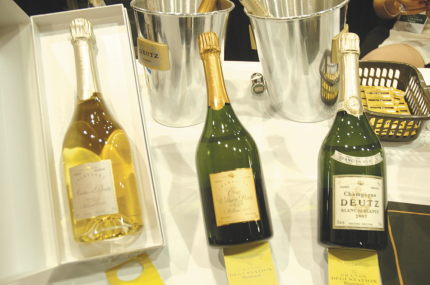
Day One
It was proud, it was loud and what a crowd at this year’s La Grande Dégustation de Montréal held November 8-9 at Place Bonaventure. This annual exhibition is a spiritual event for anyone looking for a new flavour to impress friends and family over the holidays. This is an educational opportunity for those who have spent good money for a special bottle but were disappointed with their purchase of wine or spirits. This event provides an opportunity to taste the product without having to buy the bottle. With nearly 200 producers from across the planet, there was a lot to sample.
Event organizers did their best to point you in the right direction. This year saw a panel of 14 experts judging Chardonnay and choosing the 10 best. The top Chardonnay according to the experts was Kendall-Jackson at a reasonable $22.15. Following that in order were: Folie A Deux ($24.05), Ravenswood Vintners Blend Chardonnay (I liked it and it costs $18.55), Rodney Strong Vineyards ($25.70), Hahn SLH Estate. Migration ($21.15), Chateau Saint-Jean, The Dreaming Tree Chardonnay, and in 10th spot is Stoneleigh ($18). The ones with no price are not in Quebec yet.
Two of the most interesting wines I came across were Freakshow and 88 Points, both from the Michael David Winery in California. Freakshow is an interesting wine and quite enjoyable. The label drew me in, but the taste made me ask for seconds. 88 Points was more of a fruity or berry-like taste and it exhibited the same satisfaction as a good five-course meal. More popular in Quebec is their 7 Deadly Zins at $24.40.
Two wines that come to the forefront when eating game or red meat are Pepperwood Grove (Merlot is $17.20 and the Cabernet Sauvignon at $16.95) and Trinchero’s The Show ($19.95).
Day Two
As the holiday season rapidly approaches, we think about what gifts may come our way or what we may bestow on others. Cold winter nights are more frequent than not, and we stay indoors seeking some warmth to vacate the chill that has found a place in our bones. Like Christmas, Montrealers can enjoy the annual wine-and-spirit show where winemakers and distilleries try to convince us that their wares will be the ones that create holiday memories. This year, we found comfort in old friends.
Entering the Place Bonaventure convention hall, we were warmly embraced by the standard batch, the single barrel, a honey, and winter edition of Jack Daniels. The latter two were too sweet for having straight up, but that is not to be said for the standard or single barrel.
At the same company booth was Woodford Reserve, a smooth higher-end product usually taken straight or on ice. The representative delighted us with a holiday treat of taking some Chambord raspberry liquor and combining it with Woodford and ice. The Chambord is known to enhance anything with ice cream or chocolate, perhaps even that late-night hot chocolate on Christmas Eve.
The next stop on our Christmas pilgrimage was a visit to the Jim Beam family, and never has southern hospitality been so warmly received. The Beams showcased their new product called Devil’s Cut, which was surprisingly smooth despite its name. Not to be outdone, and coming from the same family, is the Makers and Knob Creek labels. The representative boasted of having the best old-fashioned cocktail in Montreal, so we watched as he put ice, simple syrup, Makers and a marinated cherry together. He was not wrong. A warning to those who like cherries, this one had been aged two months (cask strength), and one bite felt like a hammer blow to the head and liver simultaneously – so better left for simple flavour or garnishing.
The company took great pride in telling us that 80% of the casks they use to make their bourbon whiskey are shipped to Scotland to be used for aging scotch whiskey. However, it is Irish whiskey from the Cooley family that they are most associated with. Kilbeggan is one of the best sellers worldwide, and competes at the level of Jameson’s. The step up the whisky ladder, and one that has won the most awards to date, is the Tyrconnell. Finally, for those who like peat, Connemara provides the familiar earthy and lingering satisfaction of a quality spirit.
To finish off the day, we visited the Macallan family of scotch whiskey. This popular distillery is known for its 12-year-old and 18-year-old, while connoisseurs with deeper pockets can enjoy a 25-year-old. Macallan was there to introduce its new line: instead of going with ages on their scotch, the company offers colours – Ruby, Sienna, Ambrose, and Gold.
Some Macallan lovers stopped by and engaged the company representative in a lively discussion over this new approach to scotch. They simply asked how do we determine the age of the scotch now. The company responded that they have taken the constraints off the scotch maker to allow the flavour and colour to determine the quality, and not an age on the bottle. They said that there was a difference in the aging depending on casks, whether they from the US or Europe. So they have found other ways to present their scotches.
They understand that the die-hard scotch drinkers will not likely understand or appreciate the new system, but stand behind the quality of the beverages. The issue is that the categories of scotch are still set at a high price level as they would if the ages were included. Who will pay for 25-year-old scotch made at an indeterminate time, and with potentially limitless supply? The uniqueness of good scotch and pricing is usually the time in preparation, and like wine, often a limit in quality.

